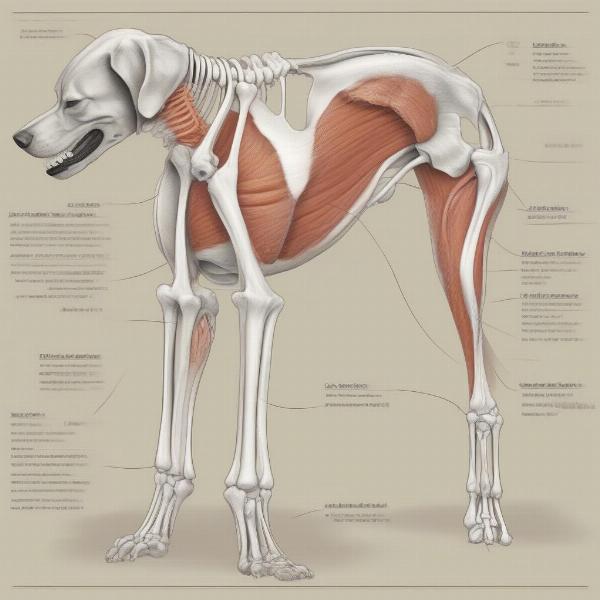Hind legs play a crucial role in a dog’s mobility, strength, and overall well-being. From playful romps in the park to everyday activities like climbing stairs or simply standing, these powerful limbs are essential for a happy and active canine life. Understanding the anatomy, common issues, and proper care of your dog’s hind legs is vital for any responsible owner.
Anatomy and Function of Canine Hind Legs
 Anatomy of a Dog's Hind Leg
Anatomy of a Dog's Hind Leg
A dog’s hind legs are a complex network of bones, muscles, ligaments, and tendons, all working in harmony to provide power and propulsion. The hip joint, where the femur (thigh bone) connects to the pelvis, is a ball-and-socket joint allowing for a wide range of motion. The femur leads down to the tibia and fibula (shin bones), which then connect to the tarsus (hock), analogous to a human ankle. The metatarsals and phalanges form the dog’s paw and toes. Strong muscles like the gluteals, hamstrings, and quadriceps power these movements, providing the force for running, jumping, and even wagging their tail.
Common Hind Leg Problems in Dogs
Unfortunately, several issues can affect a dog’s hind legs, ranging from minor injuries to more serious conditions. Hip dysplasia, a genetic condition affecting the hip joint, is common in larger breeds and can cause pain, lameness, and difficulty moving. Cruciate ligament tears, similar to ACL injuries in humans, are often the result of sudden twisting or trauma and can lead to instability and pain in the knee joint. Arthritis, particularly in older dogs, can cause stiffness, swelling, and reduced mobility in the hind legs. Other problems include patellar luxation, where the kneecap slips out of place, and degenerative myelopathy, a progressive neurological disease affecting the spinal cord.
Caring for Your Dog’s Hind Legs
Maintaining the health of your dog’s hind legs requires proactive care and attention. Providing a balanced diet rich in essential nutrients, particularly during puppyhood and senior years, is crucial for healthy bone and joint development. Regular exercise, tailored to your dog’s breed, age, and physical condition, is essential for maintaining muscle strength and flexibility. Avoid excessive jumping or high-impact activities, especially for puppies and older dogs. how to strengthen old dogs hind legs Regularly check your dog’s paws for injuries, cuts, or foreign objects. If you notice any signs of lameness, stiffness, or pain, consult with your veterinarian immediately. leg braces for dogs hind legs
How can I tell if my dog is experiencing hind leg pain?
Several signs indicate your dog might be experiencing hind leg pain, such as limping, favoring one leg, difficulty standing up or lying down, whining or yelping when touched, and reluctance to exercise or play.
What are some preventative measures for hind leg issues in dogs?
Maintaining a healthy weight, providing regular exercise, choosing appropriate bedding, and using supportive harnesses like a body leash for small dogs or a belly belt for dogs, can help prevent hind leg problems, particularly in breeds prone to hip dysplasia or other joint issues. A comfortable leather dog harness for small dog can also distribute pressure evenly and prevent strain on specific areas.
Conclusion
Your dog’s hind legs are essential for their quality of life. By understanding their anatomy, common problems, and preventative measures, you can take proactive steps to keep your furry friend happy, healthy, and mobile for years to come. Remember, early detection and intervention are crucial in managing hind leg issues and ensuring your dog’s continued well-being.
- What are the main functions of a dog’s hind legs? A dog’s hind legs are primarily responsible for propulsion, power, and balance during movement, enabling activities like running, jumping, and climbing.
- What are the most common hind leg problems in dogs? Common hind leg issues include hip dysplasia, cruciate ligament tears, arthritis, patellar luxation, and degenerative myelopathy.
- How can I prevent hind leg problems in my dog? Maintaining a healthy weight, providing regular exercise, and a balanced diet can significantly reduce the risk of hind leg problems.
- What should I do if I notice my dog limping? If your dog is limping, consult with your veterinarian immediately to determine the cause and receive appropriate treatment.
- Are certain dog breeds more prone to hind leg issues? Yes, larger breeds are often more susceptible to conditions like hip dysplasia.
- How can diet affect my dog’s hind leg health? A balanced diet with appropriate nutrients is essential for healthy bone and joint development, especially during puppyhood and senior years.
- What are some signs of hind leg pain in dogs? Limping, favoring one leg, difficulty rising, whining, and reluctance to exercise can all indicate hind leg pain.
ILM Dog is your trusted resource for expert advice on dog breeds, health, training, nutrition, grooming, and much more. We offer a wealth of information to help you provide the best possible care for your canine companion. Whether you’re a seasoned dog owner or just starting your journey, ILM Dog is here to support you every step of the way. Contact us at [email protected] or +44 20-3965-8624 for personalized advice.